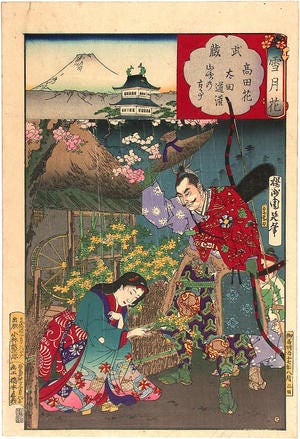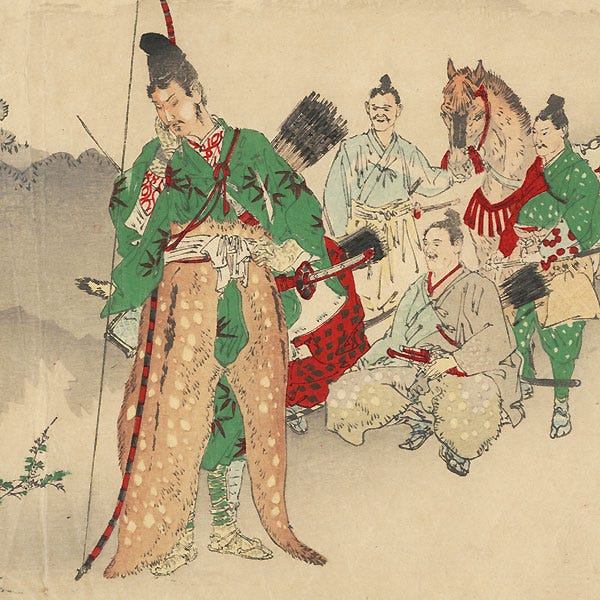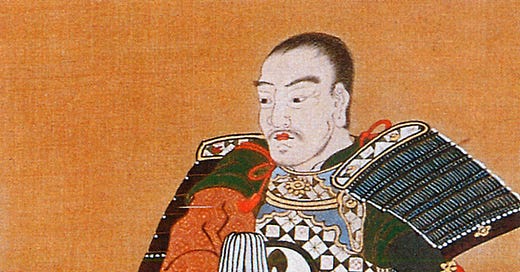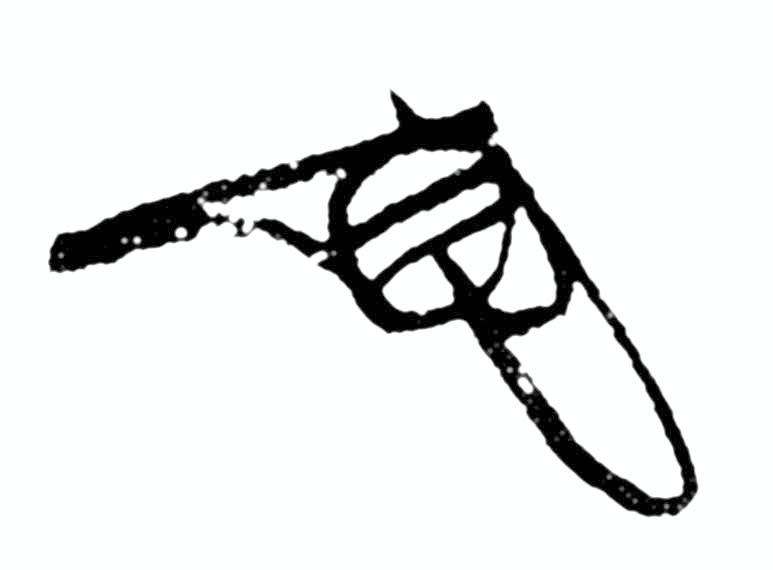Ota Dokan, Master Of Edo
The Assassination of Samurai Warrior, Man of Culture, Poet and Edo Castle's founder
Ota Dokan was assassinated on this day, August 25, 1486.
Most associate Tokugawa Ieyasu with Edo Castle. however it was another important warlord of the Muromachi Period who built Edo Castle, Ota Dokan.
Ota Dokan (1432 - August 25, 1486), also known as Ota Sukenaga, was a fine warrior, man of culture, poet and from 1478, a Buddhist monk, adopting the Buddhist name by which he is best remembered, Dokan. Dokan is also known as the architect of Edo Castle (now the Imperial palace) in modern day Tokyo.
The Ota served the Yamanouchi Uesugi clan, and Dokan attended the clan leader, Uesugi Sadamasa directly. Various branches of the Uesugi clan were competing for supremacy, and it was Dokan’s military accomplishments that almost single-handedly saved the Uesugi from crisis. In the Ota Dokanjo, diaries Dokan himself writes 'It is my greatest achievement that the Yamanouchi branch are able to rule both branches of the Uesugi.”
Dokan first built Edo Castle in 1457. The name “Edo” comes from Edo Shigetsugu, a late Heian, early Kamakura period warlord who built his fortified residence in what is now the Honmaru and Ni-no-Maru compounds. After the Edo clan were destroyed in 15th Century skirmishes, Ota Dokan built his castle on the site. In 1590, following Toyotomi Hideyoshi’s Siege of Odawara, the lands were awarded to Tokugawa Ieyasu. At the time, Edo was considered a backwater, and so Ieyasu commenced expanding and improving the castle. In 1600 Ieyasu won the decisive Battle of Sekigahara, and transferred the nations’ political center to the city that would one day become Tokyo.
Ota Dokan fought over 30 battles. Considered extremely intelligent from his childhood, he was recognised as a strong and cunning warrior too.
He studied military sciences, mastered the arts of divination, deemed essential for military strategists at the time, and was familiar with the Seven Books of Military Affairs. According to records, he wrote and sent military books to the Muromachi Shogunates’ Deputy Shogun, Hosokawa Katsumoto. Dokan's innovative tactics titled “Ashigaru Military Laws”, are believed to center on new group tactics utilizing Ashigaru foot soldiers, replacing the one-on-one combat styles fought by mounted warriors.
As a child, Dokan’s genius was recognised. According to the clan chronicles, his father, Sukekiyo, was worried about his son’s intelligence, and told him, ``If you are seen as too intelligent, you will be a threat. If you hide your wisdom, it will bring disaster. One cannot go both ways, one must be straight, or one will fall." The boy then pointed out a folding screen and retorted, "If the screen is straight, it will fall. It remains standing by going both ways."
Rebellion Suppression
Once a group of Dokan's vassals rebelled and barricaded themselves in a fortification. Dokan sent his samurai to attack them, but as they charged, Dosan shouted from the rear, "wait! Don't kill them, don’t kill them!". Hearing this, the rebels thought that perhaps they could be saved, and so they surrendered peacefully expecting to hold peace talks. On their emerging, all were killed easily.
Spank The Monkey
Another story involves the Shogun Ashikaga Yoshimasa’s pet monkey. This monkey would jump on, scratchand bite the visiting daimyo. Despite the indignation and injuries, the daimyo could not complain because it was the shogun's monkey. When Ota Dokan visited the Shogun in Kyoto, the monkey tried to pounce on him as per usual, but Dokan glowered at it, and the monkey cowered in fear. The other feudal lords marveled at Dokan's authority.
It turns out that Dokan knew about this monkey, and on arrival in Kyoto, gave the monkey handler a bribe, then beat the monkey severely. Therefore, the monkey was frightened when Dokan glared at him. The daimyo later found out about this and were even more amazed at Dokan's wisdom. (Incidentally, a similar anecdote is told of Otomo Sorin and Tachibana Dosetsu.)
In April 1478, Ota Dokan’s troops besieged Kozukue Castle (Yokohama, Kanagawa Prefecture) where Toyoshima Yasutsune was holed up. According to clan chronicles, the castle's defenses were solid and the attackers were few in number, so the siege lasted several weeks, during which Dokan composed a playful song titled "Naruto," and had his samurai sing it to boost morale, and encourage the attack.
Road to Improvement
Despite his great intelligence and self confidence, there was a time when Dokan was ashamed of himself and changed his ways for the better.
The story goes that one day while out falconing, a heavy rain began to fall. Seeking to borrow a mino, a straw rain cape, he called on a nearby rundown home, however the daughter of the household who answered the door gave Lord Dokan a branch of yellow Yamabuki or Kerria roses instead of the mino rain cape he requested. Perplexed and angered, Dokan returned home drenched in the rain, and that evening told his retainers the story of the silly girl who gave him flowers instead of a rain cape.

One of his samurai then pointed out that the flowers represented the lines from a poem written by the Heian period Prince Kaneakira. (914-987); “The Yamabuki enriches our house, but the riches are an illusion, our flowers bear no fruit.” In this case, fruit, or mi, in Japanese was a wordplay on mino,…To Dokan’s clever samurai, the meaning was simple. The family was too poor to be able to lend even Lord Ota a mino. Dokan felt ashamed at his ignorance of the poem and its meaning, and at his attitude towards the peasant girl, and so he dedicated himself to self improvement and the study of poetry.
As lord of Edo Castle, Dokan also devoted himself to training his samurai, setting up an archery field within the castle, and made them practice every day. Those who failed to attend, were fined, but the money was used tobuy tea for the warriors.
With Dokan's continued success, the power and prestige of the Ota clan began to surpass that of the clan leaders, the Yamanouchi Uesugi. Uesugi Sadamasa began to fear the loyal Dokan, who overwhelmed the enemy with his superior leadership and strategy. Sadamasa felt threatened and began to ignore Dokan'sadvice. Suspicious of repairs made by Dokan to his Edo and Kawagoe Castles, Sadamasa accused Dokan of plotting a rebellion against him. Dokan made no excuses for these slanders, but expressed his dissatisfaction with his master's cold treatment in his diaries. Concerned at the implications, he sent his eldest son, Sukeyasu, to the Deputy Shogun, Lord Furukawa Shige, as a hostage to prove his loyalty.

On August 25, 1486, he was invited to Uesugi Sadamasa’s palace residence in what is now Isehara City, Kanagawa Prefecture. According to the Ota Sukebujo records, Dokan was attacked and assassinated by Soga Hyogo with a spear as he exited the bathroom after taking a bath. He was 55 years old. As he died, he is said to have prophesied that there would be no future for the Uesugi family without him.
True to the prophesy, on Dokan's assassination, Dokan's son Sukeyasu and many other loyal samurai defected to the rival clan. Sadamasa found himself in a difficult situation, and in 1487, the two Uesugi families engaged in a long-running conflict known as the Chokyo War, bringing the clan into disrepute.
Following Dokan’s death, Edo Castle was abandoned until it was taken over by Tokugawa Ieyasu in 1590. The 'Dokan Moat' still remains in the former Edo Castle, and various statues of the fine warrior dot the cityscape. Tokugawa Ieyasu may be the better known master of Edo, but Ota Dokan was the first..





